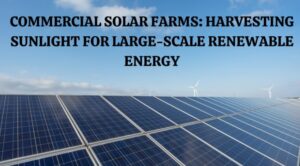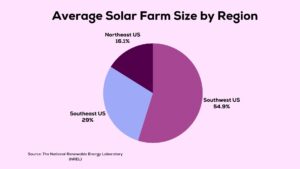
Commercial Solar Farms: Harvesting Sunlight for Large-Scale Renewable Energy
As worldwide energy needs rise quickly, solar power shines as a sustainable fix. Commercial solar farms uniquely use sunlight to make clean, renewable power at big utility-scale levels. But how exactly do these sweeping fields of panels turn rays into usable electricity? Let’s check out the ins and outs of large-scale solar power projects.
Getting Land and Checking Environmental Impact
The process of constructing a solar farm begins with securing an appropriate site. Key things to think about include location, land size, closeness to wiring infrastructure, solar power levels, and permitting needs. Solar farms typically need 5-10 acres per megawatt (MW) of capacity. Look at the data below that shows the average solar farm size (in acres) in various regions:

Finding areas with strong solar resources maximizes potential power generation. Engineers utilize solar maps that display sunlight patterns across seasons to identify optimal development locations. However, the journey doesn’t end with getting land. Hard environmental reviews are essential to ensuring sustainable building. Checks evaluate things like:
1) Effect on Ecosystems and Wildlife
Solar developers assess the potential impact of panel placement on ecosystems and wildlife habitats, adjusting layouts to protect sensitive areas. However, some animals, like sheep or chickens, can graze below or between panel rows.
2) Plant Variety Impacts
Reviews study plant variety changes from adding infrastructure like roads. Native wildflower spaces between panels aid bees.
3) Water Use Analysis
Solar makers quantify water needs for solar unit washing, fire safety, and onsite worker use to conserve water.
4) Waste Generation Planning
Assessing metal, glass, and electronics waste streams from eventual solar farm upgrades and refurbishments ensures responsible recycling. They also help large commercial solar companies, put conservation best practices into practice, like bee-friendly landscaping. Solar farms need lots of land, requiring environmental review.
Optimizing Solar Gear
At a solar farm’s core lie its photovoltaic panels. Single crystal designs lead in ratings, achieving change rates of over 22%. However, alternate technologies like thin-film and double-sided panels offer unique pluses.
| Panel Type | Efficiency Rate | Description |
| Monocrystalline | 22%+ | Made from silicon ingots, highly efficient |
| Thin-Film | 10-19% | Flexible; lower sunlight requirements |
| Bifacial | 17-22% | Captures light on both sides |
Panel Frames and Mounts
Secure metal frames durably mount solar units at optimum tilt angles to maximize solar absorption depending on location latitudes and sunlight angles. Single-axis trackers also tilt panel rows during the day to directly face the sun’s movement and capture more rays.
Inverters and Battery Storage
Importantly, these systems don’t work alone. Inverters change DC flow into usable AC power. The best inverters boast 98%+ rates. Smart models also improve grid joining, providing support during breaks. Downstream transformers will next increase voltage levels to send higher power totals to meet grid standards.
Also, battery storage allows solar farms to regulate power generation, store excess energy, and provide essential grid services. These systems are moving up fast as costs drop. Giant battery facilities hold chemical energy from thousands of lithium-ion batteries that can discharge into grids when solar production dips overnight or during storms.
Delivering Solar Power Through Grid and Money Links
Connecting Solar Sites to Energy Grid Networks
While solar panels may sparkle in sunlight, their energy must sail a tricky path to reach buyers. Joining with the electric grid needs big wiring upgrades, including new sending lines, stations, and specialized inverters for grid chat. These costs can range from hundreds of thousands to millions per megawatt. Interconnection equipment feeds electricity from solar to energy grids.
Bringing Investors Through Financial Agreements
Luckily, creative money models like power buy deals (PPAs) help bring in investors to pay for such projects. PPAs deal with solar farm owners to sell electricity to utilities or big businesses at fixed rates. These 20-25-year deals form solar energy’s money backbone while guarding ratepayers from fossil fuel ups and downs. Prominent solar developers secure investment capital from banks, private organizations, or public funds to establish renewable assets.
Corporate and Utility Solar Power Purchaser
In fact, over 75% of corporate renewable agreements involve solar power purchase agreements (PPAs). Icons like Amazon, McDonald’s, and Target use Solar’s eco and money pluses. Huge companies like Apple, Amazon, and McDonald’s use solar PPAs to meet greenhouse gas-cutting goals. Even some power utilities directly invest in mammoth solar farms to feed grids as coal use shrinks.
Pushing Solar: The Part of Policy
What has fueled the significant growth of large-scale solar projects? It’s quite simple: effective policies. Federal tax cuts lower project costs by up to 26%. State give-backs and acts push further sweetening possibilities. These measures have reduced solar costs by more than 90% since 2009, and prices continue to decline.
Support Through Streamlined Permitting and Land Access
But government support goes beyond direct giveaways through things like faster permitting, grid access guarantees, and land leases. Key policy moves make it simpler for solar makers to get approval for projects, connect systems safely to regional grids with enough capacity, and use public lands for clean energy generation. Together, these measures empower makers to deliver cheap, reliable solar power to the masses.
Operational Solar Farm Considerations
1) Building Timelines
From permitting to building and grid syncing, projects usually take 1-2 years to complete. Larger gigawatt-scale complexes can even take over 5 years to fully build in phases.
2) Environmental Effects
With eco-wise design, solar makers can minimize environmental harm while moving bio-diversity and bee habitats. Some sites purposely create wetlands or flowering zones as conservation assets.
3) Maintenance Costs and Equipment Lifespans
Tasks like solar panel washing, plant management, and replacing inverters have annual O&M costs ranging from $10,000-$25,000 per MW. Over decades, worn parts like wiring and transformers eventually need heavy replacement every 20-30 years.
Conclusion – Using the Power of the Sun
Solar farms uniquely harness sunlight to generate carbon-free renewable energy at monumental scales. Although powering our future requires extensive coordination across financial, policy, and infrastructure domains, commercial solar projects continue to make significant progress toward sustainability as costs decrease and support increases. The future looks promising for large-scale solar projects to increase access to affordable, clean electricity in communities.
Solar Farms: Frequently Asked Questions
- What’s the typical commercial solar farm development timeline?
From permitting to construction and grid synchronization, projects usually take 1-2 years to complete.
- How do solar farms impact local ecosystems?
With eco-conscious design, solar developers can minimize environmental harm while promoting biodiversity and pollinator habitats.
- What are the operational challenges facing solar farm owners?
Tasks like solar panel cleaning, vegetation management, and replacing inverters contribute to annual O&M costs ranging from $10,000-$25,000 per MW.